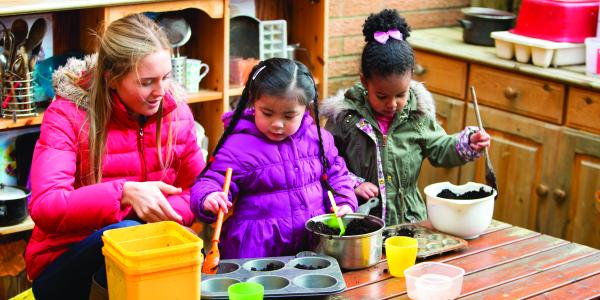Preschoolers as Eco-Artists

You are here
Theresa, a preschool teacher, sits in a circle with 4-year-olds who recently watched a video and read books about the artist Andy Goldsworthy. She asks, “Who can tell me what Andy Goldsworthy uses to make his art?”
“Ice.”
“Snow.”
“He lays outside in the rain and his body shape makes art on the ground!”
Goldsworthy’s unusual methods for creating art impressed the preschoolers. An artist and a naturalist, Goldsworthy relies on science and art to create outdoor sculptures in all types of weather. He creates with materials from the natural world, including leaves, stones, twigs, snow, reeds, and thorns.
Theresa uses Goldsworthy’s art to help the children understand the concept of ecological art, or eco-art. This type of art is special, in part, because it is not meant to be permanent. Lashanna raises her hand to add, “It disappears! It’s like when we make a snowman and it melts.”
Why expose children to eco-art?
Eco-art is an interesting blend of science, engineering, math, and temporary, open-ended, creative art. It links STEAM and project-based curriculum to early childhood settings everywhere. Children think about science in terms of the weather, their natural environments, and the materials they find outdoors. Engineering and mathematics come into play as they consider balance, structure, and composition while combining materials in 3-D creations. Children can capture their experiences with digital cameras, tablets, or smartphones so that the temporary nature of their art can be preserved through photos, on film, in books, and on documentation panels.
Introducing eco-art
- Gather photos and books. Display examples of Goldsworthy’s work in the art, science, and literacy areas.
- Involve families. Send home small brown paper bags and ask families to collect natural items from their backyards or neighborhoods with their children. Sort, classify, and sketch these items using magnifying glasses, rulers, pencils, and clipboards.
- Find nearby natural items. Walk around your program’s neighborhood with the children and encourage them to find natural items to add to the collection.
- Discuss children’s interests about nature. Talk about nature, seasons, the life cycles of plants, and so on. Use the children’s interests and questions to guide the discussion.
- Analyze art. Compare the differences and similarities between eco-art and the kinds of art that the children typically make and take home.
Constructing indoor and outdoor sculptures
Indoors
Have children choose where and with whom they want to build an eco-art sculpture. They could work alone or with others on the floor, rug, or tabletop. Try using large pieces of black paper to define the children’s work areas.
After building, documenting, and deconstructing eco-art indoor sculptures, invite the children to make a permanent eco-art sculpture. They can use a rectangular piece of wood or chipboard and craft glue to create a base for the sculpture.
Outdoors
When building outside, teachers need to consider a number of factors, including planning for the weather and getting the materials to the sculpture site. While warmer weather is probably best for working outdoors, this author completed the project in December. We used screwdrivers and hammers to make holes in the frozen earth. Then we placed large branches upright into these holes. The children built their sculptures using ideas found in physics, such as balance, gravity, and mass.
In addition, the natural materials must be transported to a site if the selected site is not on the school premises. Families and colleagues may offer to drive materials to the site before the project begins.
A simpler site choice would be the school grounds. Another class of children wove branches, flowers, and other natural items into a chain-link fence on school grounds to create their eco-art sculpture.
Video is an excellent way to document this project. It’s interesting to film preschoolers building these sculptures. Later the children can watch video of themselves on their classroom computers, bringing the creative experience into their classroom again. While they are recording, teachers can ask questions about the artistic choices that children are making. Teachers and preschoolers can reflect on this video again and again during circle time to reinforce what they learned. Videotaping can also capture the eco-art sculpture as it changes with time and with the weather, making for an ongoing scientific exploration.
For all sculptures, encourage children to name and make a sign for their artwork. Families can visit the sculptures before they are taken apart. Teachers may also wish to host a family eco-art day where everyone creates something big and wonderful together!
The authors wish to thank Cindy Gennarelli, director of the William Paterson University Child Development Center, for inspiring children and teachers to engage in ephemeral art, using materials that will change with time. Thanks also to Young Audiences NJ for integrating STEAM into preschools in New Jersey; and Patricia Becker, director of Sarah Ward Nursery in Newark, New Jersey, for exploring eco-art with the children in the preschool.
Janis Strasser, EdD, is a teacher educator and coordinator of the MEd in Curriculum and Learning Early Childhood concentration at William Paterson University in Wayne, New Jersey. She has worked in the field of early childhood for more than 40 years.
